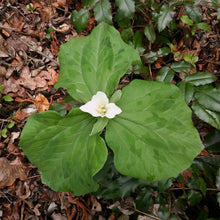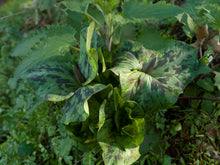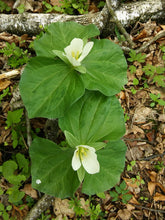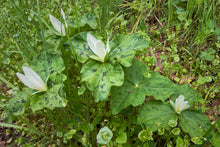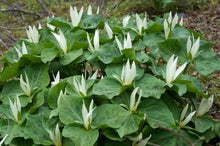
Trillium albidum
We are over-the-moon excited to offer giant trillium for the first time ever this season! This breath-taking woodland species is exceptionally long-lived and much less common, both in the wild and in terms of nursery availability, than its well-known cousin, Western Trillium. It flaunts fragrant, flame-shaped (aka “sessile”) creamy white flowers and striking, mottled “leaves”. Plant it in the dappled light of your understory, shade garden and marvel at its mind-bending tripartite symmetry; three super-sized bracts (most people think they are leaves), followed by three exaggerated sepals, then three subscending creamy white petals, shyly obscuring its reproductive parts.
- Plant type/canopy layer: deciduous, perennial, herbaceous plant
- Size at maturity: 12-24", equally wide (each bunch becomes fuller over many years)
- Light requirements: full shade, part-sun/part-shade
- Moisture requirements: moist soil, prefers well-drained
- Bloom time: March - June (statewide and in Portland Metro area)
- Growth rate/ease: grows slowly, moderately difficult to grow
- Wildlife support: flowers attract and support bees, particularly the bumble bees that pollinate it, and other insect pollinators; overall plant attracts and supports beneficial and pest eating insects
- Native habitat/range: common in mixed forests across most of the Pacific Northwest from the Cascades to the coast. Portland Plant List - yes.
- Special features & uses: medicinal; landscape uses include woodland gardens, shady pollinator gardens and shady raingardens
What to Expect + Gardening with Western Trillium: Similar to its more well-known cousin, Western Trillium, it’s important to put this bulb in a shady area with moist, acidic soils that contain lots of organic matter, such as a mature forest garden where leaf litter and woody materials are left in place.
For spring orders, depending on the weather and the date of your order pick-up, bulbs may be just emerging or already dying back for the season. Bulbs can be fragile when they're actively growing in spring. So, either plant with care or keep it in its pot and wait until it dies back before planting. By early summer, the plant will die back completely and the bulb will be easy to transplant. If you go this route, leave the pot in a sheltered place and water sparingly, so that you don't rot the bulb. For fall orders, you can expect what looks like a pot of dirt. The bulb inside may appear slightly shriveled, which is its normal, dormant fall look. Fall is generally considered an excellent time to plant bulbs - though this plant can be very rare in nurseries, so if it’s available in spring - you might want to jump on the opportunity!
Like many bulbs, be sure the soil is moist but well draining, so the bulb doesn’t rot. Trilliums can withstand minor summer drought, but supplemental water in the summer is necessary for the first few years after it’s transplanted. Admire its blooms in nature, not in a vase - as picking them will significantly diminish the plant, often eliminating blooms for several years! It is also adored by slugs so take any needed precautions to ensure you get to enjoy it more than they do!
Like many native plants in the Lily Family, the berry-like fruits evolved to have a fleshy appendage called elaiosomes that are both attractive and nutritious for ants. These tiny workers haul the seed back to their underground nests to feed the elaiosomes to their young, and leave the remaining seed embedded in their underground nests. In doing so, they are critical players in a magical dance of seed dispersal that mutually benefits both the plants and the ants. So, think twice next time you reach for that outdoor ant killer.
Photo Credit 1: "Trillium albidum 20170405_130947" by Stamnariophilus is licensed under CC BY-SA 2.0.
Photo Credit 2: "Trillium albidum" by Franco Folini is licensed under CC BY-SA 2.0.
Photo Credit 3: "Trillium albidum 20170405_132216" by Stamnariophilus is licensed under CC BY-SA 2.0.
Photo Credit 4: "Trillium albidum" by Madeleine Claire is licensed under CC BY 4.0.
Photo Credit 5: "Trillium albidum 2" by Eric in SF is licensed under CC BY-SA 3.0.





